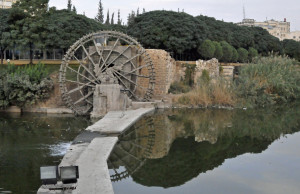
Noria in Hama, Syria in November 2010 (Photo by Don Knebel)
Hama, the fourth largest city in Syria, lies along the Orontes River that flows north from Jordan to the Mediterranean. By 1500 B.C., Hama had become an important trading city and capital of a Canaanite kingdom, mentioned in the Bible in connection with Kings David and Solomon. The city eventually fell under the control of the Romans, who began building large wooden wheels in the Orontes to lift water from the river to aqueducts, where the water flowed to fields and public buildings. Beginning in the twelfth century, Muslim rulers of Hama built additional and larger norias, seventeen of which survive. The largest one, more than 60 feet in diameter, once provided water to Hama’s grand mosque. Although the aqueducts are no longer functional, Hama’s norias have been meticulously maintained for their aesthetic and historical value.
In 1982, members of the Muslim Brotherhood in Hama revolted against the government of then President Hafez al-Assad. Assad and his government responded ruthlessly. Much of the city was destroyed by artillery fire and up to 40,000 people were killed, many of them summarily executed by government forces. By 2010, the physical damage of the so-called “Hama Massacre” had been repaired, but the lingering resentment created by the killing and destruction was one of the causes of the civil war that began in 2011.
Hama was the site of extensive fighting in 2011 and 2012 and much of the city was once again severely damaged. Recent satellite observations indicate that the fighting has so far not damaged the famous water wheels.
Comments are closed.